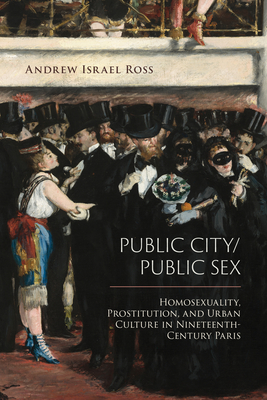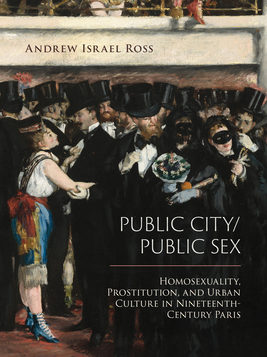 Public City/Public Sex: Homosexuality, Prostitution,
Public City/Public Sex: Homosexuality, Prostitution,
and Urban Culture in Nineteenth-Century Paris
by Andrew Israel Ross
Temple U. Press. 286 pages, $34.95
THE CENTRAL THESIS of Public City/Public Sex is an interesting and original one. Andrew Israel Ross argues that the attention to and interdiction of men seeking sex with other men in 19th-century Paris (which previous scholars have noted and investigated) were part of a larger effort by French authorities to open up and sanitize the capital. They were also an attempt to deal with some of the unexpected consequences of that modernization.
This preoccupation with making the city a healthier place to live and work in also led city fathers to install the still well-remembered public urinals, which were intended to prevent men from relieving themselves against the first available wall. One of the unintended consequences—something Ross is delighted by—is that these urinals also created public cruising areas for men seeking other men to have sex with. Because this activity became much more visible to the affluent society that the new boulevards and shopping areas were drawing into the streets, legal and medical authorities started to devote serious time to understanding it, the better to eradicate it. To this end they created a body of writing about same-sex-seeking men (eventually “homosexuals”), one that scholars have been mining since Michel Foucault first brought them to light in the 1970s.
Homosexual acts were not illegal in 19th-century France, but those engaging in or even just seeking them in public places could be arrested for an offense against public decency—which often meant offending shop owners who feared losing customers. Meanwhile, on the heterosexual front, the city’s attempts to make itself ever more attractive to tourists led to the development of an entertainment industry—bars, cafés, nightclubs—that played on Paris’ reputation as a site of uninhibited sexual pleasure, never mind that their promises of pleasure were not always fulfilled.
In other words, 19th-century Parisian authorities’ pursuit of men who sought sex with other men was at least in part a reaction to unintended consequences of opening the city up to consumerism and tourism, a bid to encourage the growing middle and upper classes to explore its newly developed public spaces. Ross’ approach here is important, because it places a particular part of gay history into a larger, and interesting, context.
One problem I had with this book, which I found slow reading, has to do with its style. The author repeats his observations too often, something that a good editor could have eliminated. Another is that the author sometimes fails to support his assertions, as when he claims that “illicit activities had so contaminated these facilities of public hygiene [the urinals]that respectable citizens could no longer use them,” but provides no sources for that. These urinals were still being used for their intended purpose by men who were probably as respectable as the next guy when I lived in Paris in the 1970s. Similarly, Ross claims that these urinals, “rather than helping men move about [the city], enticed them to stay inside,” again with no evidence. Some heterosexual Parisians—but more likely tourists from outside the metropolis—may have been shocked to see men cruise for other men, but I doubt that many of them stayed home to avoid that sight. If there’s anything that American visitors to Paris continued to comment on in the late 19th and early 20th centuries, it is that Parisians, both men and women, liked to walk about outdoors far more than their New England counterparts.
There are also passages where the author may have misunderstood his French source. He quotes a letter complaining about prostitutes who “launch invectives ‘that would make a dragon blush.’” I don’t know how prudish dragons are, but I suspect the French original spoke of dragoons, cavalrymen who were famous for their salty language. I also suspect the original used the verb “lancer,” which here would be better translated as “to throw” or “to hurl.” Similarly, Ross translates a description of a potential prostitute in another letter as “brown hair, figure a little wrinkled.” I suspect the letter writer, in using “figure,” meant “face,” which is another of its meanings.
On balance, Public City/Public Sex does a nice job of putting homosexual activity 19th-century Paris in a broader social context. I just wish it did so in a more enticing fashion.
Richard M. Berrong, professor of French literature at Kent State University, is the author of Pierre Loti(Critical Lives, 2018).







Discussion1 Comment
Merci for this review. I haven’t seen this book, but will keep an eye open for it at my local English language bookstore. As an American ex-pat living in Paris since 2006, I can attest to the fact that the public pissoirs still exist in certain areas, and while I have no doubt that it is an opportunity to cruise, there are other public areas that avail themselves to that type of activity as well. Curious if the author and research documented in the book corresponds with the current “lieus de draguer.”